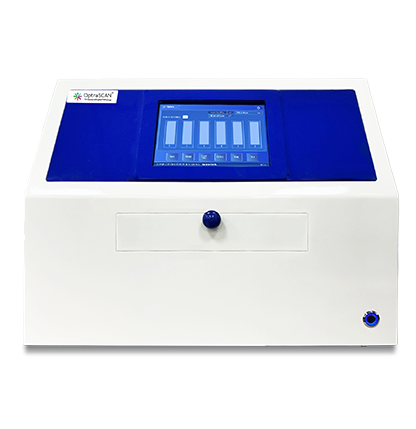

Introducing the OS-FS Frozen Section Slide Scanner, a cloud-enabled dual modality whole slide scanner featuring a Live View Mode. This innovative pathology slide scanner allows pathologists and hospital networks to collaborate seamlessly, ensuring efficient and remote pathology reviews, making OptraSCAN a leader among pathology slide scanner providers.
The OS-FS Frozen Section Slide Scanner is a versatile dual modality pathology scanner capable of processing up to 15 FFPE and 6 frozen section specimens with interchangeable cartridges. This advanced technology reduces waiting times for surgeons and patients by enabling pathologists to instantly review frozen section specimens or fine needle aspirations (FNAs) remotely using the OS-FS Live View Mode feature.
OptraSCAN's frozen section tissue slide scanners are engineered to meet the rigorous demands of pathologists and medical professionals, delivering exceptional image quality, speed, and reliability. Experience seamless integration with OptraSCAN's software solutions, including IMAGEPath and TELEPath. IMAGEPath provides robust image management capabilities for viewing, storing, and archiving, while TELEPath facilitates real-time, remote consultations, making OptraSCAN a preferred choice among pathology scanner providers.
Take a closer look at the future of digital slide imaging and explore the Frozen Section Pathology in our blog.

Intraoperative Diagnostics*: Enable pathologists to rapidly examine tissue samples during surgery, providing real-time diagnostic* information to surgeons for immediate decision-making.
Tumor Identification: Quickly evaluate suspicious lesions or tumors for malignancy, facilitating immediate diagnosis* and treatment planning.
Lymph Node Evaluation: Assist in the intraoperative assessment of lymph nodes for metastatic spread, aiding in accurate cancer staging and informing decisions on lymph node dissection and adjuvant therapy.
Training and Education: Serve as valuable tools for training pathology residents and medical students in interpreting histological specimens and making intraoperative diagnoses*.
Pediatric Surgery: Evaluate tissue samples from pediatric patients during surgery to diagnose congenital abnormalities, tumors, and other conditions requiring prompt intervention, ensuring timely and accurate treatment.
Frozen section pathology involves rapid freezing and sectioning of tissue samples for immediate microscopic examination during surgery, providing quick diagnostic* information, whereas standard histopathology involves formalin fixation, tissue processing, embedding, sectioning, staining, and microscopic examination in a laboratory setting, taking longer for results.
Frozen section pathology is utilized to guide surgical decisions by providing real-time diagnostic* information, especially in scenarios requiring immediate decisions regarding tumor margins, tissue adequacy, or presence of infection.
Biopsy specimens, surgical margins, and lymph nodes are suitable for frozen section analysis.
Frozen section pathology offers rapid diagnosis*, aiding surgeons in making immediate decisions during procedures, while also facilitating timely adjustments to surgical plans based on real-time pathological findings.
Frozen section pathology is typically comparable in accuracy to standard histopathology, with reported sensitivities and specificities ranging from 90-100%, although it may have slightly higher rates of false negatives or false positives due to rapid processing and limited sampling. This is also highly dependent on the quality of the product offered by pathology scanner providers.
Yes, frozen section pathology enables real-time intraoperative decision-making by providing rapid diagnostic* information during surgery, assisting surgeons in determining appropriate next steps regarding tumor margins, tissue adequacy, or presence of infection.